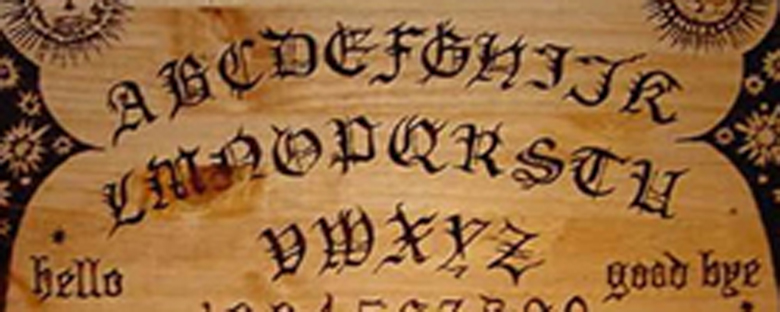Reviews
Kevin S. Tenney
UK / USA, 1986
Credits
Review by Thomas Scalzo
Posted on 20 November 2004
Source Anchor Bay Entertainment DVD
There is, amidst the back cover copy of Anchor Bay’s recent DVD release of Witchboard, the surprisingly blunt assertion that the film contains “tasty dollops of nudity, gore and humor.” Upon reading the copy, my first impression was that Anchor Bay should be applauded for their decision to so transparently cater to the cheap thrill crowd. But as I thought more about it, I wondered if the claim did the film an inadvertent disservice. By resorting to such a shameless marketing ploy, aimed no doubt at America’s credulous and nudity-starved youth, Anchor Bay risked alienating the interest of the more discerning horror viewer, those who might conclude from such a statement that Witchboard had nothing more substantial to offer than bad jokes, splattered blood, and a few tantalizing flashes of skin. Hoping to set the record straight, and provide the nation’s diverse horror audience with a more specific accounting of the film’s merits and flaws, I settled in for an afternoon of Witchboard, pen in hand, critical eye peeled.
In case you’ve never heard of the ubiquitous parlor game, a Witchboard or Ouija board, is nothing more than a flat piece of cardboard, sized to fit comfortably on the lap, displaying the letters of the alphabet, the numbers 0-9, and the words yes, no, hello, and goodbye. The apparently simple pastime is, however, overshadowed by a widespread belief in the Ouija’s supernatural powers, specifically, that the board serves as a portal allowing the living to commune with the spirits of the dead. To use the Ouija, two participants, ideally being free of any impurities, such as cigarette smoke or alcohol, sit facing each other, the board balanced on their knees. When the fingertips of the players make contact with the planchette (a plastic pointer), any spirit in the vicinity has license to enter their bodies and will slide the planchette around the board in order to answer any questions posed to it. Aside from the caveat about bodily purity, the only rule of the Ouija is to never utilize the board alone, as a solitary soul lacks the power to control the oftentimes violently unstable dead.
The story of Witchboard begins when Linda, played by “infamous 80s vixen” Tawny Kitaen, gets her first taste of the joys of summoning the dead. Throwing caution to the wind, she decides to embark on a solo Ouija effort, calling the spirit of a young murder victim named David. At first, the relationship is a cordial one, with David playing the part of the friendly ghost, and Linda that of the accommodating medium. But soon, David grows inexplicably angry, and starts using his powers to slam doors, throw knives, and blow out candles. And when those around Linda begin dying in horrific ways, all signs point to the malevolent spirit. Augmenting the problem is the fact that Linda can’t stop using the board, she’s hooked on it, and begins displaying signs of “progressive entrapment,” fancy talk for being possessed. In other words, David is trying to become Linda, in order to better carry out his increasingly nefarious plans. Hoping to get to the bottom of David’s motivations, and subsequently free Linda from her demonic prison, Brandon and Jim (Linda’s friend and boyfriend, respectively), embark on a desperate quest involving a wise-cracking medium, a road trip to the town of Big Bear, late night trespassing at the town cemetery, and an ancient killer named Carlos Malfeitor. Add in the effectively orchestrated David-haunts-Linda chase sequences, some wonderfully bloody, and rather unexpected, death scenes, and Witchboard has quite a lot going for it.
The main problem with the film, and what holds it back from joining the ranks of classic 80s horror flicks, is that it tries too hard in the wrong places, and not hard enough in the right ones. For example, instead of giving us more footage of the research mission to Big Bear, the uncovering of fascinatingly morbid secrets about Linda’s house, or more exciting death sequences, we get unnecessary doses of comic relief. Although Jim’s coworker buddy contributes his fair share of stinkers, the prize for most annoying character goes to Zarabeth the medium, a gum-snapping psychic with a penchant for bad one-liners. “I see a vision…me in your car, going home,” and “I see danger ahead…for you, if you miss my house,” are but two of the cringe inducing phrases she utters, phrases invariably followed by a wry smile and a reference to her “psychic humor.” It is difficult to express just how terrible these moments are. Suffice it to say that simply by quoting them above, I have caused myself physical pain. (I can’t even bring myself to describe the film’s bland, spineless theme song, “Bump in the Night,” which features the lyrics, “Questions may be answered by the light of the day, oh, it’s so far away, and things go bump in the night.”)
Despite its shortcomings, however, Witchboard is, in the end, worthwhile horror, a competent entry that successfully blends the less urbane features of the genre with genuinely creepy moments of terror; in short, it is a film that deserves a look by both indiscriminate viewers and genre purists alike.
We don’t do comments anymore, but you may contact us here or find us on Twitter or Facebook.



